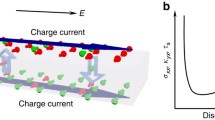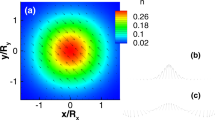Abstract
We study a conical topological insulator quantum dot and we show how the cone tip affects the surface states energy spectrum. This is obtained by analytically solving the Dirac equation for these charge carries whose dynamics is restricted to the conical surface. Besides of changing the wave-functions and energy spectrum, the conical tip also yields breakdown of spin-to-surface locking in this geometry.
Graphic abstract






Similar content being viewed by others
Data availability statement
This manuscript has no associated data or the data will not be deposited. [Authors’ comment:The data used in the graphics have been obtained by means of the software Wolfram Research, Inc. (n.d.). Mathematica, Version 12.0, by numerically solving the respective equations presented along the manuscript. The interested reader may require such data and further information by e-mailing L.G. Veiga.]
References
X.-L. Qi, S.-C. Zhang, Topological insulators and superconductors. Rev. Mod. Phys. 83(4), 1057 (2011)
X.-L. Qi, Z. Shou-Cheng, The quantum spin Hall effect and topological insulators. arXiv preprint arXiv:1001.1602 (2010)
D.E. Gomez, M. Califano, P. Mulvaney, Optical properties of single semiconductor nanocrystals. Phys. Chem. Chem. Phys. 8(43), 4989–5011 (2006)
G. Siroki et al., Protection of surface states in topological nanoparticles. Phys. Rev. Mater. 1(2), 024201 (2017)
J. Linder, T. Yokoyama, A. Sudbø, Anomalous finite size effects on surface states in the topological insulator Bi 2 Se 3. Phys. Rev. B 80(20), 205401 (2009)
M.S. Rider et al., A perspective on topological nanophotonics: current status and future challenges. J. Appl. Phys. 125(12), 120901 (2019)
D.-H. Lee, Surface states of topological insulators: the Dirac fermion in curved two-dimensional spaces. Phys. Rev. Lett. 103(19), 196804 (2009)
K.-I. Imura et al., Spherical topological insulator. Phys. Rev. B 86(23), 235119 (2012)
K.-I. Imura, Y. Takane, A. Tanaka, Spin Berry phase in anisotropic topological insulators. Phys. Rev. B 84(19), 195406 (2011)
A. Kundu et al., Energy spectrum and broken spin-surface locking in topological insulator quantum dots. Phys. Rev. B 83(12), 125429 (2011)
L. Gioia et al., Spherical topological insulator nanoparticles: quantum size effects and optical transitions. Phys. Rev. B 100(20), 205417 (2019)
J.M. Fonseca, W.A. Moura-Melo, A.R. Pereira, Geometrically induced electric polarization in conical topological insulators. J. Appl. Phys. 111(6), 064913 (2012)
V.B. Bezerra, On some classical and quantum effects due to gravitational fields. Braz. J. Phys. 36(1B), 141–156 (2006)
G. Felipe Azevedo et al., Electronic properties of single and double napped carbon nanocones. Eur. Phys. J. B 92(2), 1–11 (2019)
P.E. Lammert, V.H. Crespi, Graphene cones: classification by fictitious flux and electronic properties. Phys. Rev. B 69(3), 035406 (2004)
W.A. Moura-Melo et al., Geometrical pinning of magnetic vortices induced by a deficit angle on a surface: anisotropic spins on a conic space background. Phys. Lett. A 360(3), 472–480 (2007)
Y. Takane, K.-I. Imura, Unified description of Dirac electrons on a curved surface of topological insulators. J. Phys. Soc. Jpn. 82(7), 074712 (2013)
F.T. Brandt, J.A. Sánchez-Monroy, Dirac equation on a curved surface. Phys. Lett. A 380(38), 3036–3043 (2016)
P. de Sousa Gerbert, R. Jackiw, Classical and quantum scattering on a spinning cone. Commun. Math. Phys. 124(2), 229–260 (1989)
Z.B. Siu, S.G. Tan, M.B.A. Jalil, Effective Hamiltonian for surface states of topological insulator nanotubes. Sci. Rep. 7, 45350 (2017)
S. Zhuo Bin, M. Jalil, S. Ghee Tan, Curvature induced out of plane spin accumulation. arXiv preprint arXiv:1602.05747 (2016)
K. Kowalski, J. Rembieliński, On the dynamics of a particle on a cone. Ann. Phys. 329, 146–157 (2013)
Acknowledgement
Authors thank CAPES (Financial Code 001), CNPq and FAPEMIG (Brazilian agencies) for partial financial support.
Author information
Authors and Affiliations
Contributions
All the authors contributed equally to the article.
Corresponding author
Appendix A: Dirac equation on a conical TI
Appendix A: Dirac equation on a conical TI
The derivation of the surface Dirac equation for a conical TI was made following the general method developed in reference [17]. The effective surface Hamiltonian for the spinor \( {a} = \displaystyle \begin{bmatrix} a_+\\ a_- \end{bmatrix},\) is specified as
The approach here is analogue to the procedure in degenerate perturbation theory, as pointed out in [13]. Here, \(H_0 = H_{\bot }\) is an unperturbed Hamiltonian and \(|\pm \rangle \) are its degenerate eigenstates. To find the spectrum of the perturbed Hamiltonian \(H_{tot} = H_0 + H'\), in which \(H'= H_{\parallel }\) and \(H_{tot}=H_{bulk}\), we have to calculate the matrix elements \(\langle \alpha | H' | \beta \rangle , \ (\alpha , \beta = \pm )\) first, and then diagonalize it. Evaluation of the matrix elements leads to
where
In the expressions above,
All the averages here are taken with respect to the normal coordinate, \(\theta \). We have \( b^i_j = \partial _j (\varvec{e}_3) \cdot \varvec{e}^i\). Also, \(\varvec{\theta }_+\) and \(\varvec{\theta }_-\) are defined in equations 15 and 16. So, we can evaluate all necessary terms:
Since all the averages are over the normal component, and it is reasonable to assume that the \(\theta \) coordinate will be practically constant at the surface, we can drop the averages and we get
Substituting this quantities on the effective Dirac operator, we arrive in the conical Dirac operator for a topological insulator:
Rights and permissions
Springer Nature or its licensor holds exclusive rights to this article under a publishing agreement with the author(s) or other rightsholder(s); author self-archiving of the accepted manuscript version of this article is solely governed by the terms of such publishing agreement and applicable law.
About this article
Cite this article
Veiga, L.G., Moura-Melo, W.A. Surface states and breaking down of spin-to-surface locking on a conical topological insulator quantum dot. Eur. Phys. J. B 95, 178 (2022). https://doi.org/10.1140/epjb/s10051-022-00424-8
Received:
Accepted:
Published:
DOI: https://doi.org/10.1140/epjb/s10051-022-00424-8




